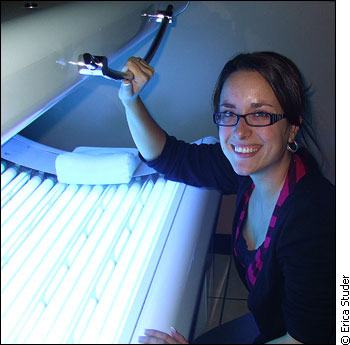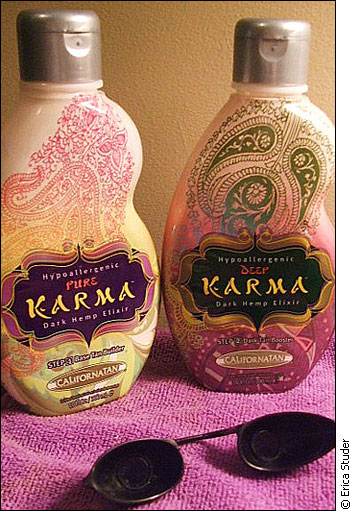Tags
Related Posts
Share This
Dying for a tan? Teens and tanning in Ottawa
It was just supposed to be the one time. She never imagined she’d get hooked, but soon she needed a fix three, even four times a week.
At 15 (Lindsay Fagan says), she became, like many of her peers, a tanning addict.
“It was one of those feel-good things, and people noticed. I got compliments,” explains Fagan, now 21. “I was definitely a regular tanner. I’d almost say borderline obsessed.”
Fagan is one of many Canadians to have fallen in love with indoor tanning as a teen. In 2006, a survey by the Canadian Cancer Society found 27 per cent of females age 16 to 24 used tanning equipment, compared to 15 per cent of those age 25 to 44.

Beauty and the beast: at an Ottawa tanning salon.
Now a Carleton University student and a more moderate tanner, Fagan admits that, back in high school, fitting in was a huge motivation for constant visits to the salon.
“Everyone was doing it. They were all getting really nice tans, and it was really attractive,” she explains. “I remember thinking, ‘Oh my God, like I really want to do it.’”
Risky business
Fagan says she tanned excessively, spending hundreds of dollars, not an easy feat for a teenager earning minimum wage.
Did she ever worry about the risks?
“Not at all,” she says. “It didn’t even cross my mind. I didn’t care. It was all about in the moment.”
Darcy MacLennan, owner of a popular Ottawa tanning salon, says she sees many teens hoping to achieve the look they admire on celebrities and their peers without being aware of the risks.
“Some teens, when they’re 15, don’t make the best judgment calls when it comes to their bodies and themselves,” she observes.
The risks are proven, but today’s teens seem willing to take their chances in order to achieve that perfect golden glow.
‘It’s like drinking. People are going to find a way to do it whether it’s against the law or not’ — Lindsay Fagan
According to the Canadian Dermatology Association, Canadians born in the 1990s are two-to-three times more likely to get skin cancer in their lifetime, compared with those born in the 1960s.
This summer, the World Health Organization labeled tanning beds as a definite cause of cancer in humans, upgraded to the same risk-level as tobacco and mustard gas.
The younger you are when you first tan or burn, the greater the risk. According to the report, tanners are 75 per cent more likely to develop skin cancer later in life if they start before age 30.
Despite such risks, MacLennan says tanning in a salon is the safest route for determined teen tanners.
“Kids, if they can’t tan indoors before the summer or before going on a trip, they go out in the sun and put on their baby oil and then they give themselves first, second, third degree burns,” she says.

Tanning lotion and protective eyewear are two safety measures many tanning salons mandate for their clients.
She says that salons with proper standards offer a safer, supervised tanning experience to those teens determined to tan, no matter what.
Legislating safety?
Parents play a key role in determining the fate of teen tanners. Fifteen is the minimum age for tanning in MacLennan’s salon, and parents must sign a waiver, giving them the final say.
But some feel that stronger measures are needed to advocate for the health and safety of Ottawa’s teenagers. In July 2009, following the Canadian Dermatology Association’s report about the risks of teen tanning, one city councillor proposed making it illegal for tanning salons to serve clients below age 18.
Alex Cullen, Bay Ward councillor, says while education is important, legislation is needed to regulate an activity that can have far-reaching consequences.
“We do want to use education. It informs people. But it’s not just a question of ‘Well, ok, I’m informed now, so I’m going to take an informed risk.’ We’re not only dealing with an impact of people’s health, but the cost to us as taxpayers dealing with those symptoms,” he explains. “It’s in the public interest to eliminate these very preventable risks to a very common form of cancer.”
In October, city council decided to scrap the ban, passing off the decision to the province, where similar legislation is under consideration. Cullen says he is disappointed by the decision but hopes there is room for change in the future.
Where there’s a will…
MacLennan says she feels that a ban would not deter teen tanners because it wouldn’t deal with the root cause. Teenagers will still crave the sun-kissed look and may turn to extreme, unsupervised tanning practices to get it.

Inviting though it seems, harsh tropical sunshine can often cause burns for unsupervised tanners, on vacation.
Citing her own experience, Fagan agrees that teens determined to tan would not be put off by a city-wide ban.
“I think it’s like drinking. People are going to find a way to do it whether it’s against the law or not,” she says. “We crossed the border to Hull when we were too young to drink here. There are places in Quebec that have tanning salons, too.”
She says that teens are motivated because tanning makes you feel good and is a convenient way to boost self-esteem and be “cool.”
“It’s a quick fix. You can’t go out and get liposuction, but you know you can go tanning and get that nice tanned look and feel better about yourself.”
Related links
The Canadian Cancer Society’s position on youth and artificial tanning
The World Health Organization’s 2009 Report
Who's at risk?
According to the Canadian Cancer Society, you should never use a tanning bed if:
- You are under 18
- You're fair skinned, have freckles and moles or burn easily
- You've had skin cancer
- There's a family history of skin cancer
- You're using medications that increase your sensitivity to UV light





